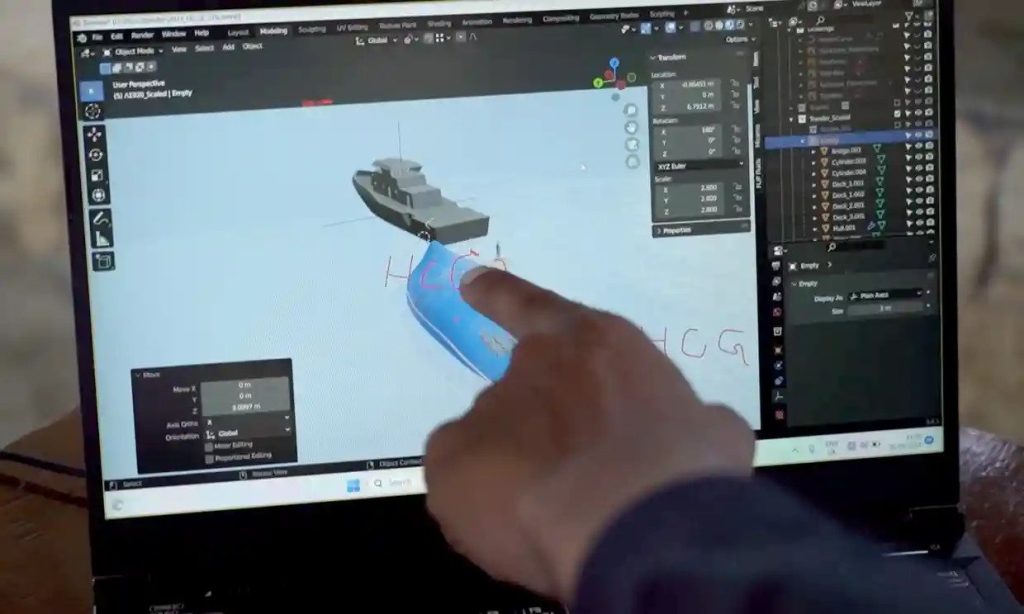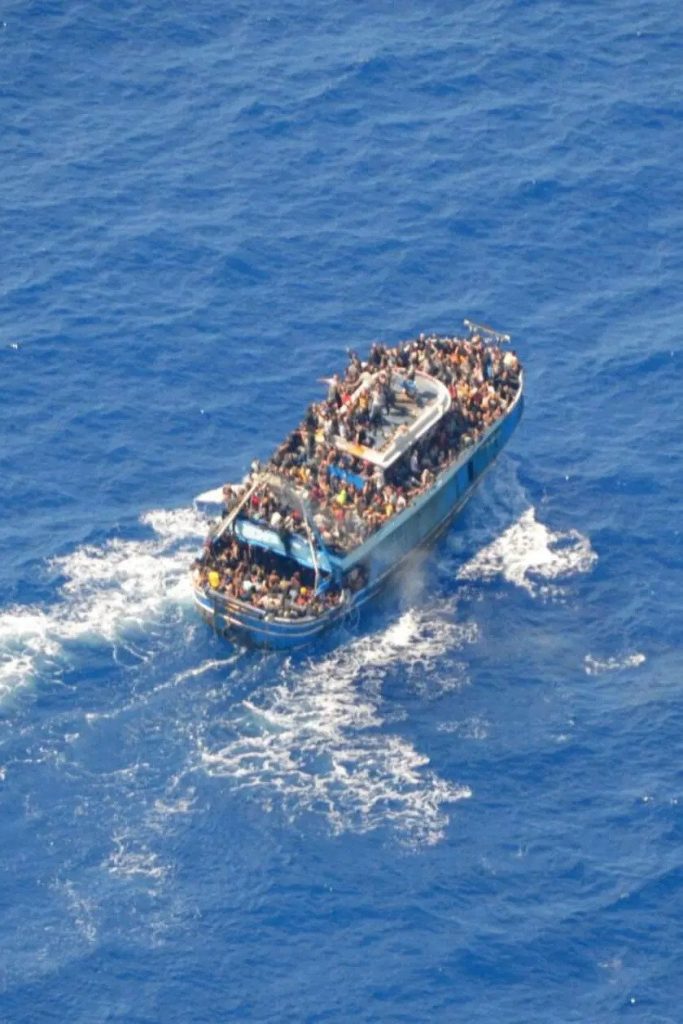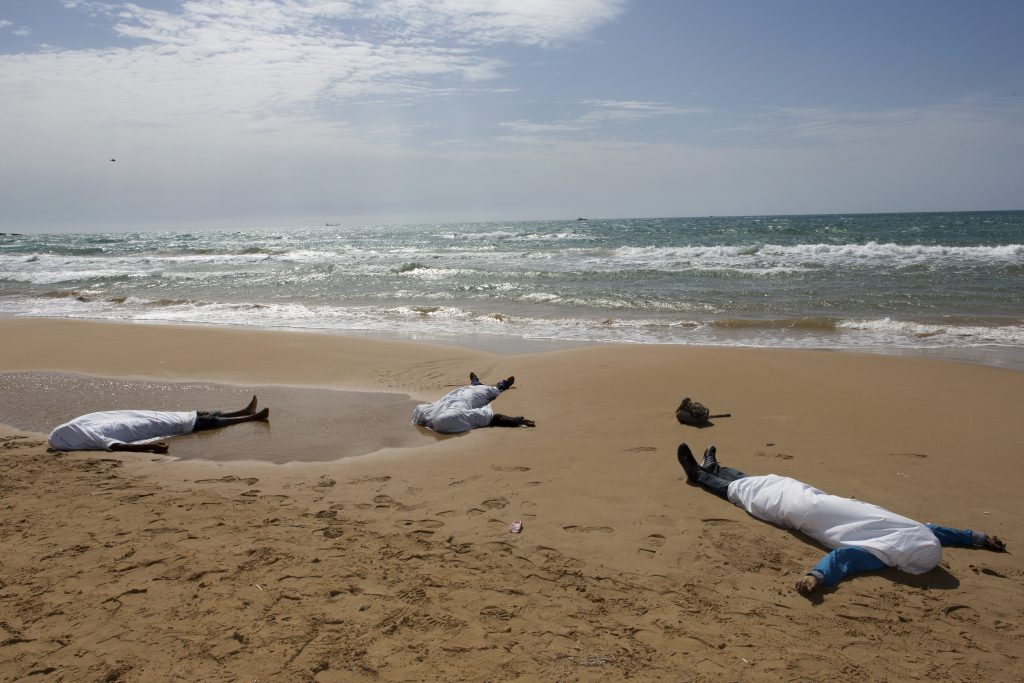OSINT is Open Source Intelligence: it is derived from data and information that is available to the general public. It’s not limited to what can be found using Google, although the so-called “surface web” is an important component. Most of the tools and techniques used to conduct open source intelligence initiatives are designed to help security professionals (or even threat actors) focus their efforts on specific areas of interest.

ABOVE: a survivor uses 3D modelling to describe their experience on the night the trawler sank.
Research into the loss of a trawler with hundreds of deaths strongly contradicts official accounts – while finding a failure to mobilize help and evidence that survivor statements were tampered with
10 July 2023 (Chania, Greece) – As I wrote last month, there was asymmetrical media coverage of two marine incidents and it was very telling – the death of over 600 migrants in the Greek boat disaster, and the Titan submersible coverage. Your life matters if you have money or come from a certain part of the world. Otherwise, sorry, bad luck. Titanic tourists sink in submarine: whole world watches as navies spare no expense to find them. Hundreds of migrants sink in overcrowded boat: Hope you can swim, losers.
From air and by sea, using radar, telephone and radio, Greek officials watched and listened for 13 hours as the migrant ship Adriana lost power, then drifted aimlessly off the coast of Greece in a slowly unfolding humanitarian disaster.

As terrified passengers telephoned for help, humanitarian workers assured them that a rescue team was coming. European border officials, watching aerial footage, prepared to witness what was certain to be a heroic operation.
Yet the Adriana capsized and sank in the presence of a single Greek Coast Guard ship last month, killing more than 600 migrants in a maritime tragedy that was shocking even for the world’s deadliest migrant route. Satellite imagery, sealed court documents, more than 20 interviews with survivors and officials, and a flurry of radio signals transmitted in the final hours suggest that the scale of death was preventable.
And now, through a high-tech investigation, the facts become clearer.
I have written about Open Source Intelligence (OSINT) many times before. My OSINT sources have been critical in my coverage of the Russia/Ukraine war. I was in Poland last year (ironically filming at the Auschwitz Nazi death camp) when the war broke out and I had my European media team with me + my Polish contacts, plus two long-time friends who are Ukrainian journalists based in Kharkiv and Kyiv, respectively. There was no better time to put together a war team. And I had one of my long-time OSINT contacts who was based in Kyiv (I had been to Kyiv for cyber war research projects and had been building an OSINT network) and he was sending me his summaries of the first hours, and then the first days, of the Russian ground and aerial assaults.
Of course, if you are an eDiscovery vendor or if you do digital investigations of any kind you know all this stuff because you use it all the time. But just to summarise for those of you who do not receive my paid subscription posts:
• OSINT has enabled many forensic breakthroughs in recent years and Bellingcat has made the most full use of it over any organisation I know. The internet remains an astonishing resource for helping redress the power imbalances between the rulers and the ruled. History is no longer just written by the winners, but filmed by the losers on their smartphones. To me, Bellingcat stands at the nexus of journalism, activism, computer science, criminal investigation and academic research.
• Its origins lie in the world of intelligence and law enforcement. It was the 9/11 Commission that in 2004 first recommended the creation of an open-source intelligence unit, a proposal reinforced a year later by the Iraq Intelligence Commission. But the methodology has found its most innovative and effective use in the hands of journalists.
• The central pursuit in open-source investigations is finding publicly accessible data on an incident, verifying the authenticity of the data, using that data to confirm the temporal and spatial dimensions of the incident, and cross-referencing the data with other digital records.
• An open-source investigator will thus start by scouring social media for postings from the area around the time. For instance, once such images are found, they will be geolocated using Google Earth to cross-referencing geographical features. The time for each image will then be confirmed, using digital sundials to calculate shadow length and direction. For instance, a route for a missile launcher can then be constructed by placing the photographs on a map along with the time for each sighting.
• For all its utility, such material always carries the risk of inauthenticity or manipulation. With the help of its ally Russia, for instance, Syria adapted to our new media environment by mobilizing armies of trolls to add digital noise to the mix, further diminishing trust in such material. This is where open-source verification becomes essential, establishing the authenticity of audio-visual material before any conclusions can be drawn from them.
• And an important note. The remoteness of open-source analysts from the subject of their analysis is not as absolute as its critics make it out to be. Much of the data used in open-source analysis comes from witnesses on the ground who have more immediate access to events. Which is certainly true in Ukraine.
• Most open-source investigators aren’t formally employed as journalists – many emerged from a gaming subculture where street cred derives from the economy and precision of one’s method – and professionals from other fields of expertise such as architecture, medicine, chemistry, finance, and law have found uses for their specialist knowledge in unraveling forensic puzzles. The British-Israeli architect Eyal Weizman has pioneered the entirely new field of forensic architecture, using open-source data for spatial investigations into human rights violations; the chemical weapons expert Dan Kaszeta has contributed to several Bellingcat investigations; UC Berkeley’s Human Rights Investigations Lab recruits from over a dozen disciplines.
• For me, this is the closest that journalism has come to a scientific method: the transparency allows the process to be replicated, the underlying data to be examined, and the conclusions to be tested by others. This is worlds apart from the journalism of assertion that demands trust in expert authority.
But for the Greek migrant tragedy, it is forensic architecture that really comes into play. Attempts by the Greek coastguard to tow a fishing trawler carrying hundreds of migrants may have caused the vessel to sink, according to a new investigation by the Guardian and media partners that has raised further questions about the incident, which left an estimated 500 people missing. The trawler carrying migrants from Libya to Italy sank off the coast of Greece on 14 June. There were 104 survivors. The Guardian notes:
• Reporters and researchers conducted more than 20 interviews with survivors and drew on court documents and coastguard sources to build a picture of missed rescue opportunities and offers of assistance that were ignored. Multiple survivors said that attempts by the Greek coastguard to tow the vessel had ultimately caused the sinking. The coastguard has strenuously denied that it attempted to tow the trawler.
• The night that the trawler capsized, 47 nautical miles off Pylos, in south-western Greece, was reconstructed using an interactive 3D model of the boat created by Forensis, a Berlin-based research agency founded by Forensic Architecture, which investigates human rights violations.
• Forensis mapped the final hours before the sinking, using data from the coastguard’s log and the testimony of the coast guard vessel’s captain, as well as flight paths, maritime traffic data, satellite imagery and information from videos taken by nearby commercial vessels and other sources. The ship’s last movements contradict the coastguard and reveal inconsistencies within the official account of events, including the trawler’s direction and speed.
• Crucially, the investigation showed the overcrowded trawler started moving westward on meeting the single Greek coastguard vessel sent to the scene. According to multiple survivor testimonies given to the Guardian and Greek prosecutors, the coastguard had told the migrants it would lead them to Italy – clashing with the official version that the trawler started moving west of its own accord. The investigation also showed the trawler had turned to the south and was almost stationary for at least an hour until, survivors said, a second and fatal towing attempt took place.
You can read the detailed report by clicking here.
NOTE TO READERS: One of the most widely accepted concepts about migration and minorities in Greece, which in fact resembles a myth, is that the latter as a nation-state has always been a homogeneous country and that only recently, namely in the 1990s, it has become an immigration-reception one. That is false. The Greek Navy and Coast Guard are complicit it trying to turn away migrant boats every chance they get, and the European Border and Coast Guard Agency, also known as Frontex, turns a blind eye to all of the documented reports of the Greeks turning their back on migrants – and actively redirecting boats back out to sea – in violation of the Geneva Convention. More of my thoughts below.
OSINT has come a long way. Many responsible publishers are investing in greater capacity for robust fact-checking and digital verification. Now, it is not only media giants like the Guardian, or the New York Times or the BBC that have the resources and the relationships to maintain fully-staffed open-source investigations units. I am heartened that organizations like Bellingcat and Forensic Architecture are receiving more and more funding.
Ever harder borders: death in the Mediterranean Sea
A vision of hell. But also a glimpse of the future.

The Adriana fishing boat disaster is a vision of hell. It is also a glimpse of the future. The Institute for Economics and Peace has estimated that by the middle of the century more than a billion people will be at risk of displacement because of ecological threats.
SIDE NOTE: And let’s play with that number a bit. On the one hand, 1 billion cannot be interpreted as anything other than “a flood” – it’s a figure that can only be seen in overwhelming terms. And it plays to the dehumanising frame of the immigration debate that many of us find repugnant. On the other hand, the “green Left” is quite fond of the 1 billion figure as it is thought to create urgency in response to the climate crisis: “Do you want a billion climate refugees? Go vegan, give up your car and holidays, ban fossil fuels!!” It’s immigration as a threat.
And so our politics will be increasingly dominated by the question of border policy. The countries of the Global North will either have to soften their borders, transforming their domestic debates on migration, or harden them, making graveyards of their seas and borderlands.
There is no doubt which looks more likely.
The European Union deploys ever more resources to prevent migrants reaching the continent, and more than 27,000 people have disappeared in the Mediterranean since 2014. The UK’s post-Brexit border policies amount to a withdrawal from international conventions on the rights of refugees. Under the latest legislation, people are not permitted to claim asylum unless they arrive by an official route, which is impossible for most refugees. Anyone entering the UK “illegally” will be banned forever from claiming asylum or applying for citizenship, and so will their family. The government now plans to “house” asylum seekers in offshore barges.
A key part of the new border regime is the siphoning away of public sympathy and attention. On the day the Adriana sank, the UK media focused on the Westminster circus of the Privileges Committee and its denunciation of Boris Johnson. The BBC uncovered evidence that the Greek authorities were lying about their role in the disaster, but this did little to boost the story’s profile. The more than 500 deaths barely appeared on UK or European front pages, and after 2 days the story hardly featured in the news at all. For some time, many media outlets insisted on reporting only the “confirmed” deaths, which stood at around 80, even though it was evident that 100s had been on board and were now missing. Previous sinkings with mass loss of life – such as the boat that went down off the coast of Calabria at the end of February, killing at least 94 people – were long forgotten.
On 18 June, the Titan submersible went missing in the depths of the Atlantic Ocean carrying five wealthy tourists. The incident received worldwide, rolling coverage of the unsuccessful search for survivors, which involved several navies and research vessels. The U.S. Coast Guard sent push notifications to the mobile devices of anyone interested in following the search, and the White House briefed that President Biden was “watching events closely”. When it was confirmed that the craft has suffered a catastrophic implosion, almost every daily newspaper in the UK and Europe (and, of course, the U.S.) ran with the story on their front page, with many carrying portraits and profiles of the 5 dead men.
The mass drowning of migrants does not meet the media’s criteria for a human-interest story because the victims have been dehumanised. Although it is worse than that. The real problem is that the capsized boat story aligns with, rather than contradicts, our expectations – migrant deaths by drowning have become completely normalized. This is a similar problem to the many thousands of life-years lost to pollution from burning fossil fuels, which receive far less coverage than the (far, far smaller) number of deaths from nuclear accidents.
Centuries of racist conditioning have led us to this point, but there is a new strategy at work, too. Donald Trump and Suella Braverman have an air of performative stupidity, and it comforts the liberal commentariat to believe that the far right’s spell in power is a blip.
But their project is deadly serious and for the long term. Trump’s “big, beautiful wall” and the UK government’s plan to deport asylum seekers to Rwanda would have been unthinkable 20 years ago. The core narrative of the nationalist right, that migrants and foreigners are to blame for falling living standards, now dominates the mainstream. It feeds popular demand for the militarization of our borders.
And 3 weeks ago you had the European Commission President, Ursula von der Leyen, and Giorgia Meloni, the Prime Minister of Italy, promising Tunisia $1 billion to stem the flow of migrants crossing the Mediterranean. So you go to a knowing oppressive regime, and you give the oppressor money so that person is more powerful and now able to oppress his people more with that new power you gave him – and then you wonder why people want to leave? They drown because of an EU policy that doesn’t want people fleeing oppression.
Across Europe and the Western world, the establishment parties of the centre and centre-left are at best hesitant about presenting an alternative vision for how we might handle migration in an era of ecological collapse. In the European Parliament, the social democrats oppose the worst excesses of the far right’s immigration policy but support the basic principle of hardening Europe’s borders. Emmanuel Macron’s presidency has brought some of the most authoritarian immigration measures in France’s history. Keir Starmer’s Labour Party is focused on exposing how the Conservatives have “lost control of our borders”. The Danish Social Democrats have used their time in government to ramp up deportations and enact mass evictions of migrant communities; they even briefly pursued an offshore detention agreement with Rwanda.
By contrast, the nationalist right knows what it wants and is dragging mainstream opinion behind it. Today’s inhumane migration policies are a warm-up act. “Stop the Small Boats” is a slogan with which many nominally progressive politicians are at pains to agree.
But behind the slogan is a wider agenda – to soften public attitudes for a crime against humanity. If the recent Greek boat disaster is anything to go by, the strategy is a success.